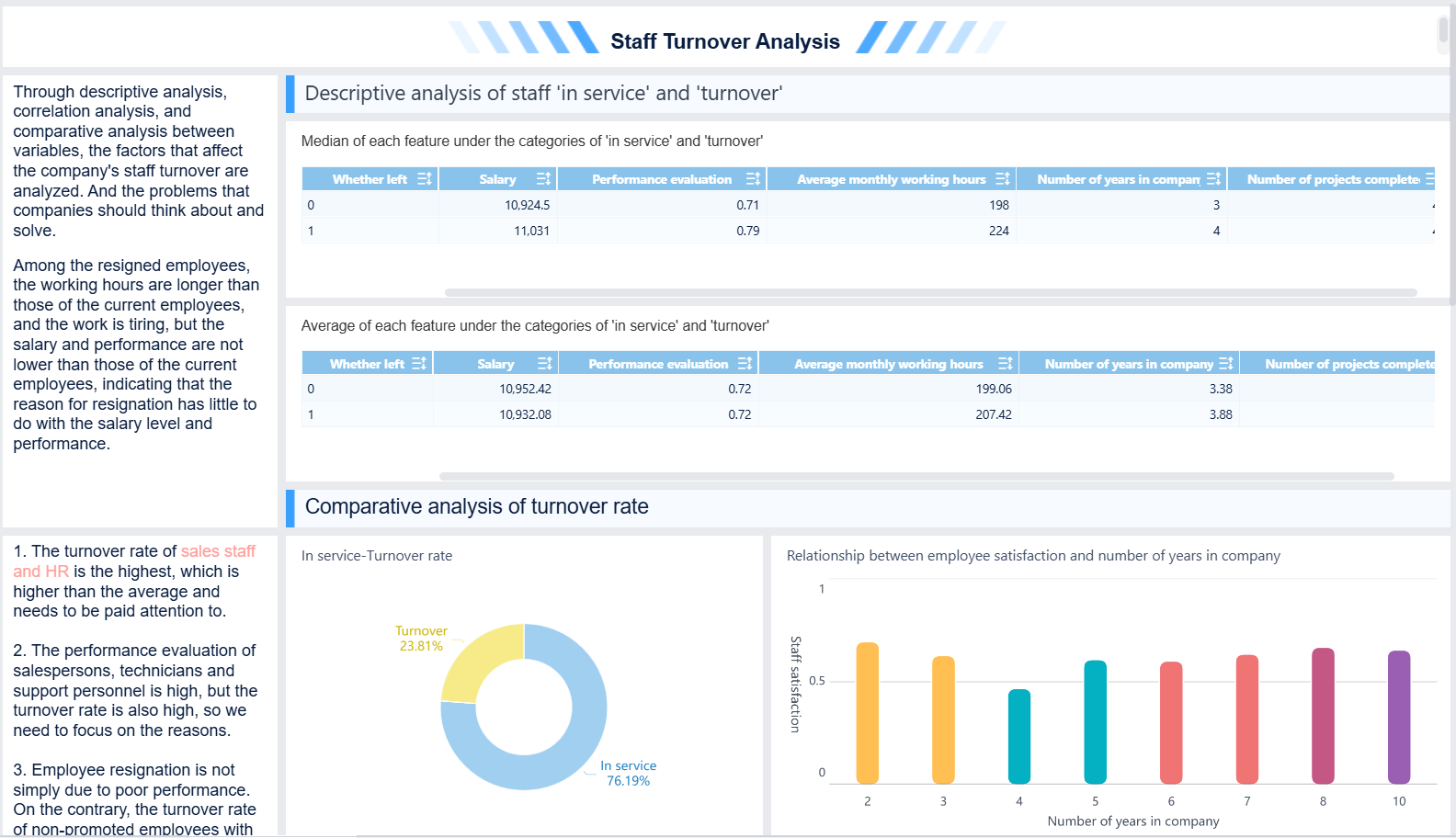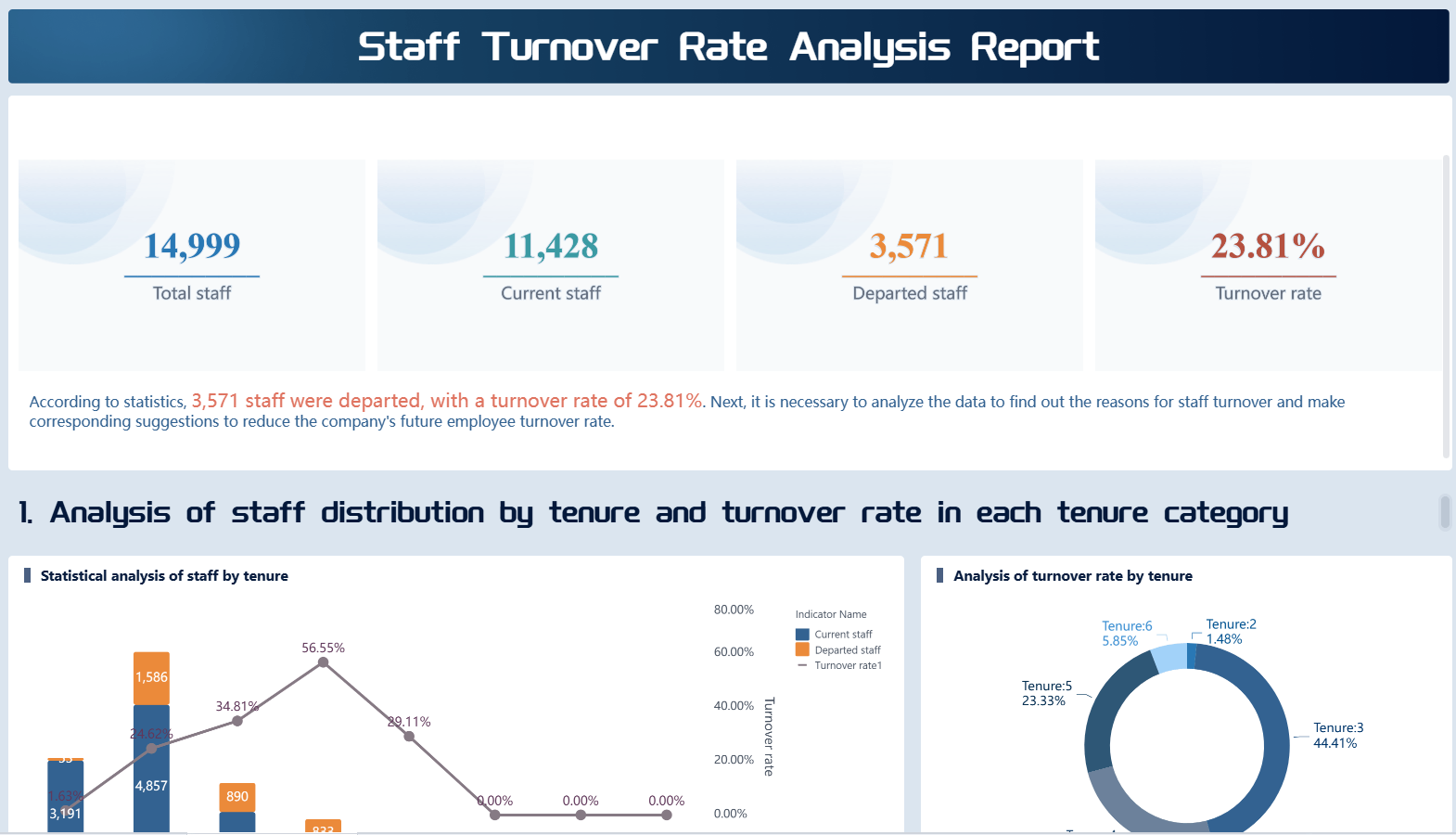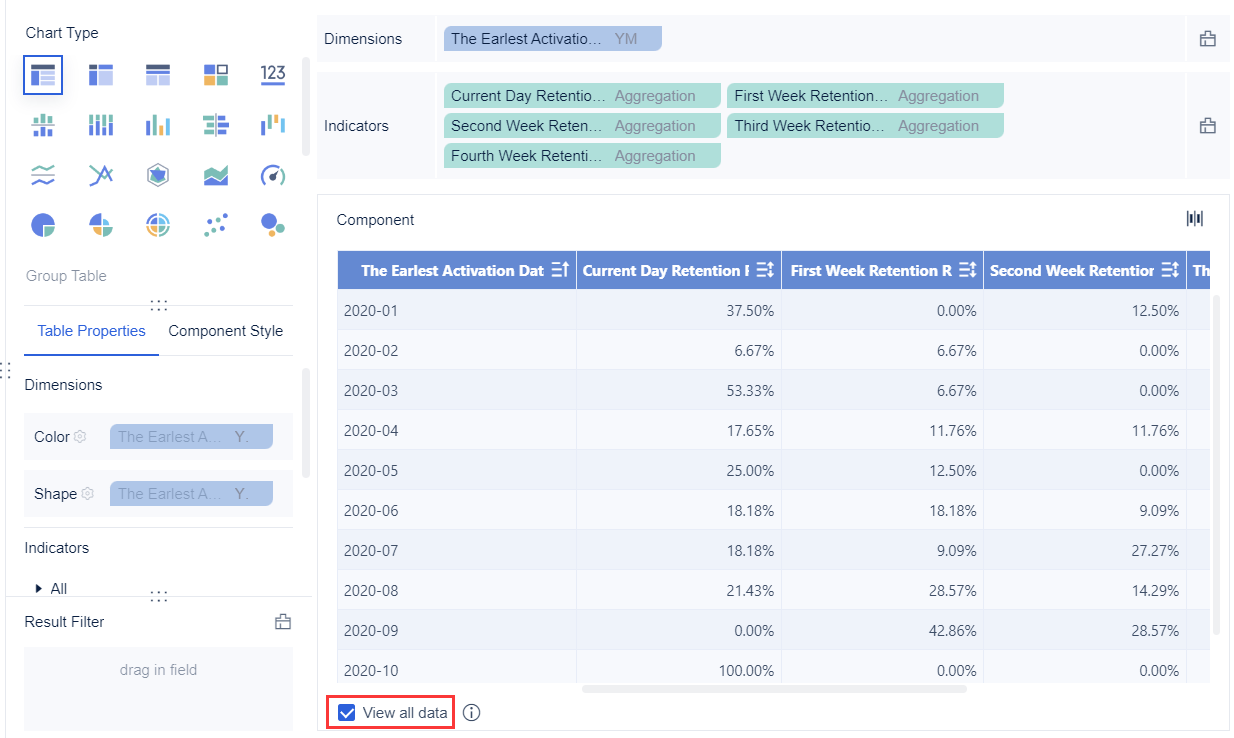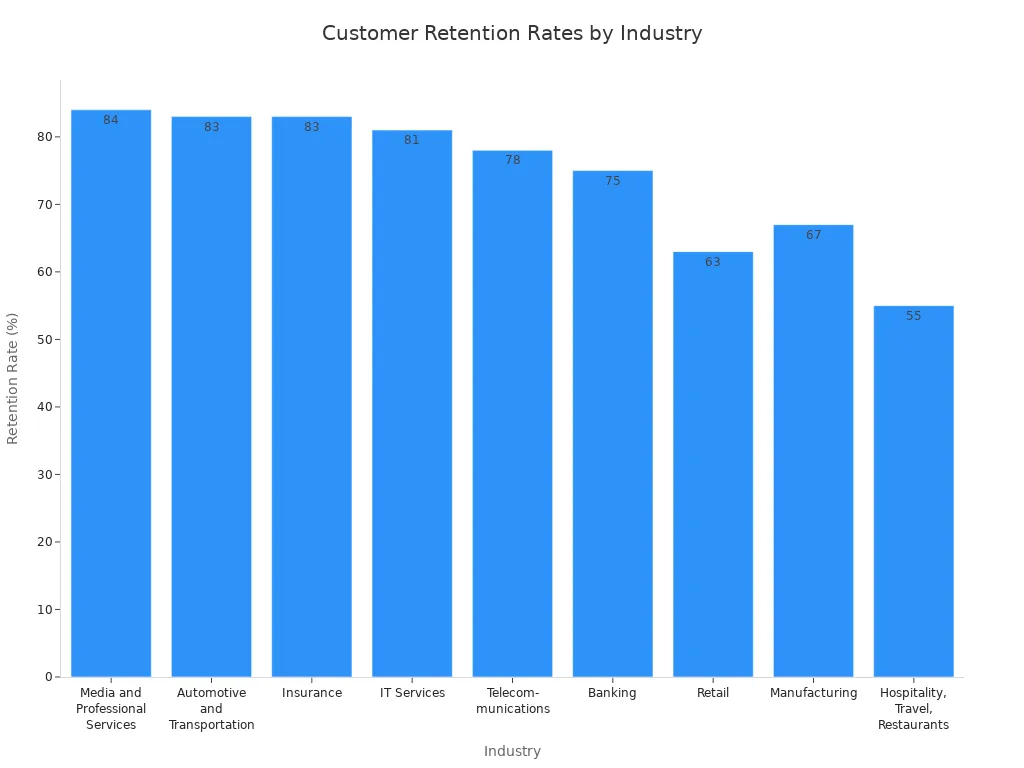Retention rate measures the percentage of individuals or customers a business keeps over a specific period. The basic formula is:Retention Rate = ((Number at End of Period – Number Acquired During Period) ÷ Number at Start of Period) × 100%.
Both employee retention rate and customer retention rate play crucial roles in business success. High employee retention rate lowers costs and supports stability, as replacing an employee can cost up to four times their annual salary. Many industries show turnover rates below 15%, but some, like retail, reach nearly 25%.
Retention of employees and customers leads to steady revenue, higher profits, and a stronger workforce. FanRuan and FineBI help organizations track what is retention, analyze employee retention rate, and improve retention strategies using real-time data and clear dashboards.
Key Takeaways
- Retention rate shows how many employees or customers stay with a business over time, helping measure loyalty and stability.
- High retention saves money, boosts productivity, and creates a positive work environment that supports growth.
- Calculate retention rate by excluding new hires or customers from the ending count to get an accurate picture.
- Tracking retention with tools like FineBI helps spot trends, set goals, and improve strategies using clear data and visuals.
- Improving retention involves recognizing employees, offering growth opportunities, and building strong customer relationships.
What Is Retention
Definition
Understanding what is retention helps organizations measure how well they keep their employees over time. In a business context, retention means the ability of a company to keep its employees and maintain a stable workforce. High retention shows that employees feel satisfied, supported, and motivated to stay. Companies that focus on retention often provide career development, strong management, and learning opportunities. These efforts help maximize employee retention rate and reduce the costs linked to hiring and training new employees. When organizations ask what is retention, they look at how their actions affect the number of employees who choose to stay.
Retention is not just about numbers. It reflects the health of the workplace. If employees feel valued, they are more likely to stay. A high employee retention rate signals that the company has a positive culture and effective leadership. When organizations understand what is retention, they can create strategies that keep talented employees for the long term.
Key Metrics
Companies use several key metrics to measure retention and understand workforce stability:
- Employee Retention Rate: This metric shows the percentage of employees who remain with the company during a set period. A high employee retention rate, often above 90%, means the company keeps most of its employees.
- Employee Turnover Rate: This measures the percentage of employees who leave, either by choice or through dismissal. High turnover can point to problems with morale or management.
- Average Employee Tenure: This is the average time employees stay with the company. Longer tenure suggests employees are satisfied and the company is stable.
- Absence Rate: This tracks unplanned absences. High absence rates may signal low engagement or job dissatisfaction among employees.
- Employee Satisfaction Rate: Surveys and feedback help measure how happy employees feel at work. High satisfaction often leads to better retention.

Tip: Tracking these metrics helps organizations spot trends, address issues early, and improve employee retention rate.
Why It Matters
Business Impact
Retention plays a critical role in business success. When organizations achieve a high employee retention rate, they save money and boost productivity. Companies that keep employees longer spend less on recruiting, onboarding, and training new staff. For example:
- A report found that a 12% drop in turnover can save up to $7,000 per employee.
- Replacing highly-trained employees can cost more than 200% of their annual salary.
- High turnover costs organizations over a trillion dollars each year.
Employees who stay with a company develop deeper knowledge and stronger relationships with customers. This leads to better service and higher customer satisfaction. Engaged employees feel empowered to solve problems and deliver quality work. Companies with high retention see about 21% higher productivity and up to 23% more profit. When employees remain, they help create a positive work environment and support business growth.
Poor retention, on the other hand, increases costs and lowers morale. High turnover forces remaining employees to take on extra work, which can lead to burnout and lower productivity. It also damages the company’s reputation and makes it harder to attract new talent. These problems reduce revenue and slow down growth.

FanRuan and FineBI Benefits
FanRuan and FineBI give organizations the tools to understand and improve retention. FineBI integrates data from many sources, offering a complete view of employee behavior and retention trends. With self-service tools, business analysts can track employee retention rate, analyze cohort data, and monitor engagement without needing advanced technical skills.
FineBI’s dashboards display real-time retention metrics, making it easy to spot trends and share insights. Visualization tools like line charts and cohort heatmaps help identify where employees drop off and what drives them to stay. Organizations can segment employees by factors such as hire date or department to uncover deeper insights. Automated reporting and scheduled dashboard updates ensure that leaders always have the latest information on employee retention rate.
Retention Rate Calculation
Calculate Employee Retention Rate
Organizations rely on retention metrics to understand how well they keep employees over time. To calculate employee retention rate, follow a clear process that ensures accuracy and consistency. Measuring employee retention helps leaders spot trends and make informed decisions.
Step-by-Step Guide to Calculate Employee Retention Rate:
- Select the time period for analysis, such as a quarter or a year.
- Count the number of employees at the start of the period.
- Identify how many of those employees remained at the end of the period. Exclude any new hires who joined during the period.
- Divide the number of retained employees by the starting number of employees.
- Multiply the result by 100 to get the retention rate percentage.
For example, if a company starts with 50 employees, ends with 58, and hires 16 new employees during the period, subtract the new hires from the ending count (58 - 16 = 42). The employee retention rate is (42 ÷ 50) × 100 = 84%. This means 84% of the original employees stayed through the period.
Note: Always exclude new hires from the retained count. Including them can inflate the retention rate and give a false sense of stability.
The standard formula for employee retention rate is:
Employee Retention Rate = ((Number of employees at end of period − New hires during period) ÷ Number of employees at start of period) × 100
A high employee retention rate signals a healthy workplace and strong management. Companies use this metric to compare departments, track progress, and set goals for improvement.
Customer Retention Rate Calculation
Businesses also track customer retention to measure loyalty and long-term value. The formula for customer retention rate is similar:
- Find the number of customers at the end of the period (E).
- Subtract the number of new customers acquired during the period (N) from E.
- Divide the result by the number of customers at the start of the period (S).
- Multiply by 100 to get the retention rate percentage.
For example, if a business starts with 100 customers, ends with 100, and gains 10 new customers, the calculation is [(100 - 10) ÷ 100] × 100 = 90%. This shows that 90% of the original customers stayed.
Tip: Use the same time frame for all calculations to ensure accurate trend analysis.
Common Mistakes When Calculating Retention
- Failing to subtract new hires or new customers from the ending count.
- Mixing voluntary and involuntary turnover, which can hide the real reasons for employees leaving.
- Ignoring internal moves, such as promotions or transfers.
- Not adjusting for seasonal or temporary employees.
- Using different time periods for each calculation.
- Not using technology to automate and check calculations.
Avoiding these mistakes helps organizations calculate your retention rate accurately and make better decisions.
FineBI Example
FineBI makes it easy to calculate your retention rate and visualize the results. The platform connects to multiple data sources, allowing users to analyze employee retention rate across departments and time periods.
How to Analyze Retention with FineBI:
- Upload employee data into FineBI. Include fields such as employee ID, hire date, termination date, and department.
- Create a dataset that filters employees based on the selected time period.
- Add calculation fields for employee retention rate using the formula described above.
- Use drag-and-drop tools to build dashboards. Place the time period (such as year or month) in the Dimensions area.
- Add the calculated retention rate fields to the Indicators area and format them as percentages.
- Visualize retention trends with line charts, bar charts, or cohort heatmaps. These visuals help leaders see where retention drops and which departments need attention.

For more details about the procedures of doing retention analysis, refer to the Help Document.
Best Practice: Keep dashboards simple and focused on key metrics. Use filters and drill-down features to let users explore data by department, job level, or location.
FineBI supports real-time updates, so leaders always see the latest retention data. The platform also allows for collaborative annotations, making it easy for teams to discuss trends and plan actions. By using FineBI, organizations can track employee retention rate, identify patterns, and design strategies to improve retention.
Presenting Retention Data to Stakeholders
FineBI dashboards help translate technical data into business language. Use clear headings, annotations, and visualizations to guide users through the insights. Highlight key takeaways, such as changes in employee retention rate or areas with high turnover. Enable interactive features so stakeholders can filter data and focus on what matters most to them.
Note: Personalize dashboards for different roles. For example, HR managers may want to see retention by department, while executives may focus on overall trends.
Good Retention Rate
Benchmarks
A good retention rate depends on the industry and the type of workforce. Many organizations use benchmarks to compare their performance with others in the same sector. For example, professional services often achieve a retention rate of 90% or higher, while retail and hospitality sectors typically see rates around 70%. The following table shows typical good retention rates by sector:
| Sector/Industry | Typical Good Retention Rate |
|---|---|
| Retail & Hospitality | Around 70% |
| Professional Services | 90% or higher |
Customer retention rates also vary by industry. Media and professional services reach about 84%, while hospitality, travel, and restaurants average 55%. The chart below illustrates average customer retention rates across different industries:

Improving customer retention by just 5% can increase profitability by 25% to 95%. This demonstrates the strong link between retention and business success.
Influencing Factors
Many factors influence employee retention rate and overall retention. These include industry challenges, company size, and workforce demographics. For instance, healthcare faces high turnover because skilled professionals often receive better offers from competitors. Technology companies experience turnover due to rapid innovation and competitive salaries. Startups may accept higher turnover, while large corporations focus on stability.
Key factors that affect retention include:
- Flexible work arrangements: Over 58% of workers value schedule flexibility, and 57% would change jobs for it.
- Training and development: Nearly half of American workers would switch jobs for better training opportunities.
- Job satisfaction: Employees who feel satisfied are more likely to stay.
- Compensation and benefits: Competitive pay helps retain employees.
- Workplace culture: Supportive and inclusive environments foster loyalty.
- Leadership and management: Good managers build trust and transparency.
- Recognition and rewards: Ongoing feedback and appreciation matter.
Organizations must also consider customer satisfaction, personalized engagement, convenience, and loyalty programs when aiming to improve customer retention. Each of these factors plays a role in shaping how long employees and customers remain with a business.
Improve Retention
Strategies

Organizations can boost retention by focusing on proven methods that address both employee and customer needs. For employees, research highlights several effective approaches:
- Recognize contributions and provide regular feedback to increase job satisfaction.
- Build strong relationships between managers and team members.
- Align company culture with employee values to foster commitment.
- Offer career growth and professional development opportunities.
- Provide competitive compensation and personalized benefits.
- Promote work-life balance to reduce burnout.
- Create a supportive and collaborative work environment.
- Develop retention strategies based on feedback and turnover data.
Simple actions, such as flexible schedules and clear communication about advancement, can make a big difference. Comprehensive onboarding and mentorship programs also help new hires feel welcome and supported. Many successful companies invest in professional development and recognition programs to lower turnover and raise the employee retention rate.
Customer retention also relies on targeted actions. Companies can:
- Deliver high-quality products and services to build trust.
- Personalize interactions using customer data.
- Launch loyalty programs with exclusive offers.
- Provide excellent support across multiple channels.
- Ensure smooth onboarding for new customers.
- Use marketing automation to maintain brand presence.
- Apply upselling and cross-selling techniques thoughtfully.
- Treat customer relationships as partnerships.
- Expand touchpoints to increase engagement.
- Offer VIP treatment to reward loyalty.
- Address mistakes transparently and recover service quickly.
Case studies show that targeted communication, continuous engagement, and personalized content can significantly improve retention and customer lifetime value.
Understanding and tracking retention rate drives business growth and stability. Companies that use FanRuan and FineBI gain a clear view of employee and customer loyalty. Key takeaways include:
- Retention KPIs reveal satisfaction and loyalty, supporting data-driven decisions.
- High retention lowers costs and increases referrals.
- Ongoing efforts like engagement tracking and loyalty programs improve results.
Organizations should define clear analytics goals, collect accurate data, and choose the right tools. They can foster a data-centric culture by training employees and using continuous learning. These steps help businesses improve retention and achieve long-term success.
Click the banner and unlock the power of retention rate calculation for business growth with FineBI.
Continue Reading about What is Retention
What is Pareto Chart and How Does it Work
How DuPont Analysis Helps You Understand Your Business
FAQ

The Author
Lewis
Senior Data Analyst at FanRuan




